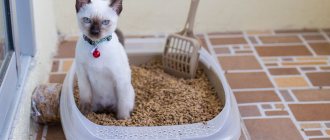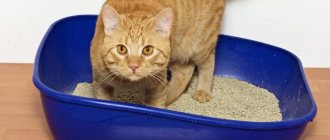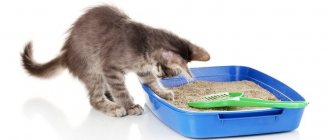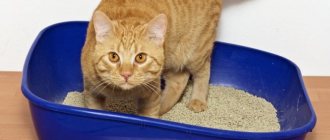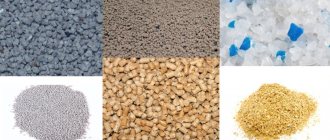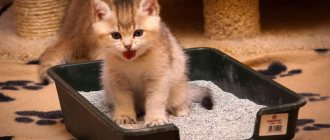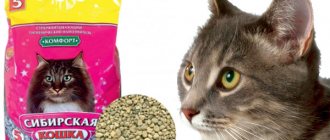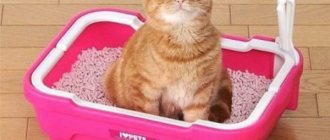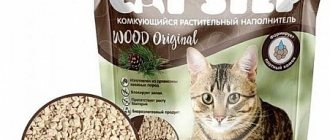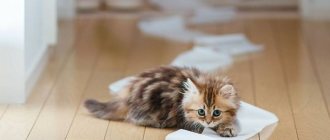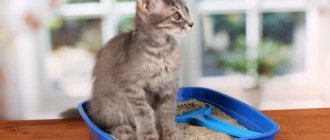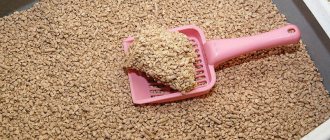What will you learn from the article?
- Mineral fillers
- Wood litter for cat litter
- Silica gel cat litter
- Japanese fillers
- PI-PI-BENT Classic
When going to the litter box, the cat is guided by natural needs and instincts. Undoubtedly, cat owners benefit from this. After all, knowing what our pet needs and knowing how to train a kitten to use a litter box can make life easier for everyone. Today you will find out which cat litter is best and my review of its types.
Fillers are very important for the comfortable coexistence of people and cats. First, the litter helps the cat understand where to go to the toilet. After all, if there is nowhere to rummage and nothing to rake in, then perhaps it is not a toilet at all. Secondly, cat litter absorbs unpleasant odors and, thus, makes life for people around cats more comfortable.
But what is the best cat litter to use, since there are so many different types of cat litter available today?
Many years ago, cat litter was filled with newspapers torn into small pieces and sand from a nearby sandbox or pond. But today it is extremely unhygienic and even dangerous for the health of people and especially cats.
Therefore, I suggest that you throw these two options aside and try to figure out what kind of litters are out there and what is best to choose for your cat.
Depending on the composition, cat litters are divided into:
Mineral fillers
Granular litters made from clay bentonite and polygorskite rocks (Fresh Step, Murka, Bars, Katsan, Jimpet Biocats, Vitacraft Compact Ultra, etc.) Such litters perfectly absorb moisture and odors, forming a lump (the so-called clumping cat litter), which is easily removed from the tray using a spatula.
Mineral filler
According to reviews, the advantages of such fillers are that they are easy to clean, do not stick to the paws, and there are fillers with granules of different sizes that will suit your pet.
The disadvantages include the fact that mineral fillers are not recommended for use on kittens, since if a kitten swallows such a lump, it can cause blockage of the digestive tract. It should also be noted that such fillers cannot be disposed of in the sewer system.
Wood litter for cat litter
Sawdust from coniferous trees compressed into granules. Wood fillers are great for both kittens and adult cats (Clean Paws, Supercat, Comfort).
Wooden cat litter
Wood litters are absorbent litters for cat litter, i.e. they absorb moisture, but do not form a lump, but simply crumble. According to reviews, the advantages of such fillers are low cost, natural origin and safety of use. Wood filler can be safely thrown into the sewer without any harm to the pipes.
The disadvantages of wood pellets are that they are less economical than mineral ones, require more frequent replacement and are very light, so cats who like to dig deep in their litter box will easily scatter such filler outside their toilet.
Among the natural and safe for kittens, we should also note fillers made from grain waste, namely corn. This type of filler is similar in characteristics to wood filler, but so far it is less common in our pet stores. One of the few such fillers is Nature's Miracle toilet filler. Corn litter for cat litter is economical, it is cheap, but it does not contain odors and, frankly speaking, it smells quite unusual, which can especially scare away your pet.
Silica gel cat litter
The most expensive type of filler (Trixie Fresh & Easy, Best Pet, Mister Clean, etc.) are granules of absorbent silica gel, which perfectly absorbs moisture and odors. Such fillers require replacement approximately once a month, as they quickly absorb moisture and odors, prevent the growth of bacteria, but remain dry to the touch. All you need to do is remove solid waste from the tray.
Silica gel filler
According to reviews, the advantages of such a filler are more than obvious. But the disadvantages include the high cost; many cats do not like this litter, because when the pet uses it, a crunchy sound appears, which not only the animals, but often the owners do not like.
Japanese fillers
Japanese cat litters are gradually gaining the attention of cats. And this is not at all surprising, because Japanese fillers are presented in a wide range, are environmentally friendly and quite economical, as manufacturers say. Such fillers can be safely thrown into the sewer system without fear of harming either communications or nature.
Here is just a small list of the extensive range of Japanese cat litters:
- clumping filler made of paper and starch with a color indicator;
- clumping litter made from crushed cypress wood and corn starch;
- clumping carbon filler made from Japanese cellulose with the addition of charcoal;
- Tofu filler is made from compressed soy fibers.
And these are not all types of Japanese cat litters presented in pet stores in Ukraine and Russia.
Flavorings for cat litter
Many manufacturers add various flavors to their products, which additionally absorb unpleasant odors or help attract cats to the litter box. I would not recommend buying fillers with scents like orange and the like. But many cats really like the light aroma of lavender and additionally attracts them to the tray.
Interesting:
- remedies for cat odor indoors;
- how to stop a cat from shitting;
- how to train a cat to use the toilet.
How to choose the right filler
Main parameters that determine quality:
- Adsorbing and deodorizing properties - the ability to absorb moisture and reduce odors. These properties depend on the composition of the material from which the filler is made and the technology of its production.
- Safety. It should be taken into account that some types of fillers may contain substances that can cause allergic reactions in both animals and humans. If the litter is used for kittens, it must be safe if accidentally ingested, the same if there are small children in the house.
- Ease of use and disposal.
An important element when choosing a filler is its price. The filler is a consumable material and therefore part of the monthly family budget will be spent on its purchase. Here it is important to choose an affordable price-quality ratio that will completely suit the owner.
What is best for a kitten?
At first, the baby will need to be provided with the filler that he used before. This will remind the kitten of its mother, her smell, will help prevent stress and speed up adaptation to the new environment.
If for some reason the previous mixture does not suit the owners, they select another product. You cannot immediately introduce a new bedding, but only a few days after the cat appears in the house. This should be done gradually, pouring the substance into the tray in small portions.
For kittens, formulations with small granules and no flavorings are best. Wood, corn, and paper bedding would be a good choice. Such mixtures are considered hypoallergenic, unable to provoke life-threatening conditions if swallowed.
Many manufacturers produce products suitable for younger pets.
The most reliable and safe include:
- "Ever Clean"
- "Barsik";
- "Cat's Choice"
You will need to stop using silica gel options. Such mixtures tend to produce specific sounds, squeaks and rustles, which are often liked by adult cats, but can scare away babies.
Price
The price of fillers varies widely and depends mainly on the material used and the production technology used by the manufacturer.
The cheapest fillers are made from sawdust, paper and grain industry waste.
Mineral fillers belong to the middle price category - they are made from natural minerals and their mixtures.
The most expensive and modern ones are silica gel fillers. Silica gel is a mineral synthetic sorbent obtained by the interaction of sodium silicate (liquid glass) and sulfuric acid.
The most famous and popular fillers in the domestic market are the following brands : “Pretty Cat”, “Barsik”, “Kotyara”, “Kuzya”, “Zoonik”, “Siberian Cat”, “Pi-Pi-Bent”, “Brava” Clean Paws”, “C.C. Cat” and others.
Popular imported ones : “Catsan”, “Cat's Best”, “Cats Choice”, “Silicat”, “Super Cat”, “Fresh step”, “Kat Step”, “CleanyKat”, “Ever Clean”, “Ultra Lite” and etc.
Wood fillers
They are made from wood waste from the processing of pine, spruce and, less commonly, fir. They are granules that, when exposed to moisture, swell and crumble into small components.
Due to their low cost, wood fillers are in good demand and popularity. Many people prefer this type of filler because of its naturalness. Wood filler is safe for animals, especially kittens.
The wood of pine trees contains resins, which give the wood filler antiseptic properties. After use, the filler can be applied as fertilizer.
It absorbs moisture quite well and eliminates odors, but these indicators are lower than those of other types of fillers, so the filler needs to be changed more often; it is consumed faster.
Another drawback is lightness. When burying, the cat can scatter it around the tray, so you need a deep tray with sides rounded inward.
Scattering into fine dust, it sticks to the paws and spreads throughout the apartment.
If you prefer this type of filler, guided by considerations of naturalness, safety and cheapness, then it would be a good idea to purchase a special closed toilet with a mat.
The walls of the closed toilet will not allow the cat to scatter the litter around the tray, and the mat will clean the paws from adhering particles and prevent them from being dragged around the apartment.
When using this filler, a tray with a grid is also convenient; whole granules will remain on the surface, and the used ones will be sifted through the grid into the tray.
Wood filler differs from other types of fillers in its ease of disposal. It can be flushed down the toilet. To avoid clogging, rinse off the filler in small portions.
Wood filler: pros and cons
Pros:
- LOW PRICE
- ECOLOGICAL CLEANNESS
- USE FOR KITTENS
- EASY TO DISPOSAL
Minuses:
- HIGH CONSUMPTION
- STICKS TO FEET
- REQUIRES FREQUENT REPLACEMENT
Fillers made from corn and paper are similar in properties and price to wood fillers.
Absorbents for cat litter
Absorbent bedding has a principle of operation that is different from the “mechanism” of clumping mixtures. After the cat visits the toilet, this litter retains its structure, while retaining moisture and odors.
In the manufacture of absorbent compositions the following is used:
- clay;
- corn;
- wood sawdust.
Such products are convenient for use in homes with several cats. They are also suitable for pets that periodically visit the street.
Next, you can study the positive and weak sides of absorbent compositions:
| Advantages | Flaws |
| Rapid absorption of large volumes of liquid. High-quality neutralization of urine odor. Low price. | The ability to generate dust, cause frequent sneezing, stick to cat paws. Quick consumption. Presence of a human-specific aroma. |
There is another feature of absorbent bedding - even if only half of the filler is used in the tray, the cat is able to stop going to the toilet and wait for a fresh mixture to appear.
Absorbents need to be replaced frequently. There are certain advantages to this. Regular renewal of the substance and frequent washing of the container help to avoid the proliferation of harmful microbes and infection of the pet.
Mineral fillers
Mineral fillers are somewhat more expensive than wood fillers and are also in high demand.
The ability of mineral fillers to absorb moisture and retain odors is better than that of wood fillers.
They are made from natural mineral raw materials - soft clay minerals and hard minerals from sedimentary and volcanic rocks. There are also artificial mineral fillers made from sibit.
In addition to the starting material, mineral fillers differ in:
- The method of absorbing and retaining moisture – clumping and absorbent fillers;
- Granule size – large, small and medium granules;
- Availability of flavoring additives – flavored and non-flavored.
The disadvantage of this type of fillers is their dustiness. During transportation, the granules rub against each other, forming fine dust, which can cause allergic reactions.
Higher quality fillers have a denser consistency and generate less dust.
What is the difference between absorbent and clumping litters?
Absorbent fillers absorb moisture through the entire surface of the material from which the filler is made, without forming lumps. The absorbency is due to the porous structure of the mineral.
Such minerals, for example, include zeolites, which perfectly absorb moisture and insulate odor.
The activity of the absorbent filler is lost gradually. From time to time, it can be mixed to evenly distribute more active and less active granules.
The absorbent filler is replaced at once, that is, the used filler is completely removed, and a fresh portion is poured into the tray, in the volume indicated on the packaging.
Clumping fillers not only have absorbent properties, their granules, when moistened, stick together into a lump, isolating the wet area from the rest of the filler.
A complete replacement of the filler is not required; it is enough to remove the formed lumps with a special spatula. The filler is poured into the tray as needed.
They are made mainly from bentonite clays of different compositions. During the manufacturing process, they can be subjected to thermal or chemical treatment to improve quality.
Natural mineral fillers have antibacterial properties.
Which filler is better at removing odor, absorbent or clumping?
Both fillers cope with odors approximately equally well, but do it in different ways.
Clumping, enveloping the wet area, locking the smell inside the coma. Absorbents, due to their porous structure, are able to absorb urine and neutralize its odor through ion exchange reactions, then evaporating clean water.
Among both there are more and less quality ones, it depends on the composition of the raw materials and production technology.
According to the results of the television program “Test Purchase”, out of 10 popular brands of clumping litter, first place went to the “Pretty Cat” brand. Second and third, fillers from the “Clean Paws” and “Catsan” brands.
Mineral filler: pros and cons compared to wood filler
Pros:
- ABSORBES LIQUID BETTER THAN WOOD;
- BETTER ABSORB ODOR;
- MORE ECONOMICAL AND CONVENIENT USE;
- DOES NOT SPREAD AROUND THE APARTMENT;
Minuses
- MORE EXPENSIVE;
- DUSTY WHEN POURED;
- NOT DISPOSED THROUGH THE TOILET.
Silica gel filler
Silica gel litter is the most modern, highly effective and practical litter for cats.
- Its cost is quite high and, perhaps, this is the only reason that does not allow it to displace all other types of fillers from the market.
- It consists of white translucent crystals with the addition of a substance that eliminates unpleasant odors.
- The granules can be irregular or regular round in shape. Among the white granules, granules of other colors may be present in small quantities.
- They act as an indicator - when urine comes into contact with them, they change color. By their number in the filler, the owner can determine when it is time to replace the filler in the tray.
- The absorption capacity of silica gel is extremely high, and it completely eliminates all odors. Silica gel is very economical, a small amount is enough for two or three weeks for one cat.
- Although expensive, this litter can be cost-effective if you have multiple cats in your home.
- Has an aesthetic appearance.
- Among the disadvantages, in addition to the high price, it is necessary to note the specific crunch that the filler makes during use. Some cats find this crunching sound frightening.
Important! This litter should not be used for small kittens.
Selico-helium filler advantages:
- ECONOMICAL CONSUMPTION
Minuses:
- HIGH PRICE
Kitten litter CAT STEP Compact White Baby Powder clumping
In the catalog on our website you will find bentonite litter designed specifically for kittens.
Production Features
CAT STEP Compact White Baby Powder is made from natural white bentonite clay. Clumps form on contact with liquid, preventing dirt from forming in the tray and effectively trapping odors. The delicate aroma of baby powder is activated upon contact with liquid and fills the room with freshness.
The filler is consumed economically due to the formation of even and compact lumps. Filler granules are perceived by kittens as a natural material, and most babies do not require additional training to use the tray.
Kitten litter does not generate dust because it goes through several stages of dust removal. White bentonite clay is an environmentally friendly material that is not exposed to chemicals.
The best litter for Maine Coon
Maine Coon cats are the largest domestic cats in the world, therefore, they excrete the most urine of all cats in the world, therefore, they need the best litter in the world - silica gel.
But seriously, a Maine Coon cat, except for its size, is not fundamentally different from its smaller brothers and all of the above applies to it as well.
For a kitten of this breed, it is better to use natural fillers made of wood, paper or corn. It’s good if the owner takes some of the used litter from the breeder and puts it in the kitten’s tray, so he will quickly understand where his new litter box is now.
In the future, you can use any filler at the discretion of the owner and with the approval of the Maine Coon himself.
Features of choice
The best cat litter is the one that suits the pet and is safe for cats and humans.
The best in terms of safety is wood cat litter. It does not contain chemical compounds and is suitable for cats with allergies.
Silicate granulate significantly saves time on cleaning, but is the choice for the litter box of adult cats. Silicone litter is not suitable for kittens.
It is better not to use a scented product for cats. The pet must know for sure that this is his place, his smell, so he will go here. The aroma may discourage your cat from visiting the litter box.
When using a specific cat litter, it is important to monitor your cat's reaction. If she doesn't like the pellets, she will ignore the toilet.
The transition to another type of backfill should be gradual. It is recommended to gradually add new filler to the old one, increasing the portion from time to time until it is completely replaced.
